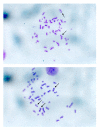Effect of borax on immune cell proliferation and sister chromatid exchange in human chromosomes
- PMID: 19878537
- PMCID: PMC2776007
- DOI: 10.1186/1745-6673-4-27
Effect of borax on immune cell proliferation and sister chromatid exchange in human chromosomes
Abstract
Background: Borax is used as a food additive. It becomes toxic when accumulated in the body. It causes vomiting, fatigue and renal failure.
Methods: The heparinized blood samples from 40 healthy men were studied for the impact of borax toxicity on immune cell proliferation (lymphocyte proliferation) and sister chromatid exchange in human chromosomes. The MTT assay and Sister Chromatid Exchange (SCE) technic were used in this experiment with the borax concentrations of 0.1, 0.15, 0.2, 0.3 and 0.6 mg/ml.
Results: It showed that the immune cell proliferation (lymphocyte proliferation) was decreased when the concentrations of borax increased. The borax concentration of 0.6 mg/ml had the most effectiveness to the lymphocyte proliferation and had the highest cytotoxicity index (CI). The borax concentrations of 0.15, 0.2, 0.3 and 0.6 mg/ml significantly induced sister chromatid exchange in human chromosomes (P < 0.05).
Conclusion: Borax had effects on immune cell proliferation (lymphocyte proliferation) and induced sister chromatid exchange in human chromosomes. Toxicity of borax may lead to cellular toxicity and genetic defect in human.
Figures






Similar articles
-
Genotoxic effects of borax on cultured lymphocytes.Southeast Asian J Trop Med Public Health. 2009 Mar;40(2):411-8. Southeast Asian J Trop Med Public Health. 2009. PMID: 19323026
-
No effect of high-dose medroxyprogesterone acetate on the frequency of sister chromatid exchange in lymphocytes of cancer patients.Oncology. 1988;45(1):57-60. doi: 10.1159/000226531. Oncology. 1988. PMID: 2963244
-
Effects of boric acid and borax on titanium dioxide genotoxicity.J Appl Toxicol. 2008 Jul;28(5):658-64. doi: 10.1002/jat.1318. J Appl Toxicol. 2008. PMID: 18027356
-
[Effect of streptolysin "O" on cell division and sister chromatid exchange].Genetika. 1980;16(8):1495-7. Genetika. 1980. PMID: 7193161 Russian.
-
Molecular mechanisms of sister-chromatid exchange.Mutat Res. 2007 Mar 1;616(1-2):11-23. doi: 10.1016/j.mrfmmm.2006.11.017. Epub 2006 Dec 6. Mutat Res. 2007. PMID: 17157333 Review.
Cited by
-
Gene expression alterations of human liver cancer cells following borax exposure.Oncol Rep. 2019 Jul;42(1):115-130. doi: 10.3892/or.2019.7169. Epub 2019 May 23. Oncol Rep. 2019. PMID: 31180554 Free PMC article.
-
Carbon Nanodots from an In Silico Perspective.Chem Rev. 2022 Aug 24;122(16):13709-13799. doi: 10.1021/acs.chemrev.1c00864. Epub 2022 Aug 10. Chem Rev. 2022. PMID: 35948072 Free PMC article. Review.
-
Biomass-Derived Carbon Dots and Their Sensing Applications.Nanomaterials (Basel). 2022 Dec 17;12(24):4473. doi: 10.3390/nano12244473. Nanomaterials (Basel). 2022. PMID: 36558326 Free PMC article. Review.
-
Boronate Ester Hydrogels for Biomedical Applications: Challenges and Opportunities.Chem Mater. 2024 Jul 9;36(14):6674-6695. doi: 10.1021/acs.chemmater.4c00507. eCollection 2024 Jul 23. Chem Mater. 2024. PMID: 39070669 Free PMC article. Review.
-
Improving Mechanical Properties of Starch-Based Hydrogels Using Double Network Strategy.Polymers (Basel). 2022 Aug 29;14(17):3552. doi: 10.3390/polym14173552. Polymers (Basel). 2022. PMID: 36080626 Free PMC article.
References
-
- National Coalition Against the Mis-Use of Pesticides (NCAMP) " Least Toxic Pesticides-Borates". Washington DC. 2001.
-
- Tobacman JK. Filament disassembly and loss of mammary myoepithelial cells after exposure to lamda-carrageenan. Cancer Res. 1997;57:2823–2826. - PubMed
LinkOut - more resources
Full Text Sources

